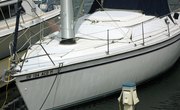
Aluminum boats have several advantages over wood and fiberglass. They have lighter gross weights, which make them highly maneuverable, faster and more economical to run. Wood rot, typical in wooden hulled boats, does not affect aluminum, nor does aluminum shatter upon impact like fiberglass. This makes aluminum boats easier to repair than other designs. Unfortunately, all boats suffer impact damage, collision or hard-grounding that can lead to leaks and cracked seams. Fortunately, special brazen rods have been designed specifically to patch and fill in holes on damaged aluminum boats, allowing boat owners to perform self repairs.
Items you will need
3 saw horses
Acetone
Rags
Particle mask
Gloves
Assistant
Body hammer
Hand anvil
Epoxy glue
Aluminum strips, scrap metal, thin gauge
Drill motor
Grinding cone bit
220-grit sandpaper
Propane torch
HTS-2000 brazing rod
Flat file
Step 1
Remove the boat from the water and take it to a sheltered garage or port. Place three sawhorses in a triangular configuration on a level surface. Have an assistant help you lift the boat up and balance it hull side up on the three points formed by the saw horses. Clean the damaged area on the aluminum with some acetone and rags, removing algae, mud and all chemical water stains. Wear a particle mask and gloves for protection. Place the boat in such a position as to face the hole or crack at its highest upward position.
Step 2
Have your assistant hold the hand anvil while you wield the hammer. If the aluminum has suffered a collision impact that has dented the metal inward, you will need to pound the dent out from inside the hull with a body hammer, while your assistant provides a backstop with the hand anvil. Straighten the profile of the hull as best you can by repeated tapping and straightening -- you need the stretched aluminum to conform closely to its original shape.
Step 3
Determine the size of the crack or hole and whether you need to back it with some scrap strips of aluminum. If so, dab a small amount of epoxy on a thin strip of aluminum and glue the piece to the underside of the boat directly over the crack. This will provide a trough for the brazen rod material to settle in.
Step 4
Use a drill motor and a grinding cone bit to grind a V-shaped channel in the crack. In the case of a hole puncture, bevel the inside of the hole with the cone bit, grinding only enough away to provide more surface area for the brazen weld to adhere to. Sand the surface area of the crack with 220-grit sandpaper, overlapping the crack area on all sides.
Step 5
Use a propane torch to heat up the crack area thoroughly. Scrape a wire brush over the area, using crosshatch strokes to rough up the aluminum surface. Hold steady heat on the crack while you apply a tip of HTS-2000 brazen rod over the crack sides. Let the brazen melt and flow into the crack or hole, filling it up. Melt the brazen rod onto the damaged area to cover and overlap it completely. While it cools, scrape the wire brush over it to remove small slag and residue.
Step 6
Use a flat file to grind away any excess brazen material that protrudes up past the aluminum panel surface. You want a nice even profile, without removing the thickest part of the brazen weld. Remove the scrap aluminum material from the underside of the hull. For added strength and protection, you and your assistant can flip the boat over and sand the inside part of the crack area. Run another bead of heated brazen weld over the crack area, and then file it down.
References
Writer Bio
Chris Stevenson has been writing since 1988. His automotive vocation has spanned more than 35 years and he authored the auto repair manual "Auto Repair Shams and Scams" in 1990. Stevenson holds a P.D.S Toyota certificate, ASE brake certification, Clean Air Act certification and a California smog license.



